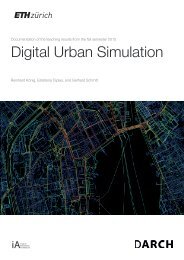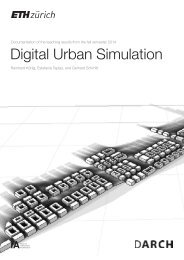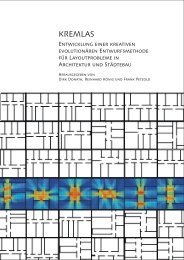New methods in urban analysis and simulation
Documentation of teaching results from the spring semester 2015 of the seminar Digital Urban Simulation at the Chair of Information Architecture, ETH Zurich
Documentation of teaching results from the spring semester 2015 of the seminar Digital Urban Simulation at the Chair of Information Architecture, ETH Zurich
Create successful ePaper yourself
Turn your PDF publications into a flip-book with our unique Google optimized e-Paper software.
Decay of the<br />
periphery<br />
Empty space<br />
at city center<br />
Decay of the<br />
periphery<br />
Empty space<br />
at city center<br />
4 < geometry ><br />
The first approach to f<strong>in</strong>d<strong>in</strong>g a design solution is by generat-<br />
<strong>in</strong>g geometry completly through a grasshopper def<strong>in</strong>ition.<br />
The def<strong>in</strong>ition creates a box controled by different<br />
param- eters. Then this box is evaluated through a fitness<br />
function tak<strong>in</strong>g different design aspects <strong>in</strong>to consideration<br />
for further optimization <strong>and</strong> comparasion between different<br />
possibilities. Those are: alignment with the rest of the city,<br />
general volume, centrality, fitt<strong>in</strong>g <strong>in</strong>side the solar envelope<br />
<strong>and</strong> compactness.<br />
The fitness function tries to level them out so they all have<br />
an ideal value around 1 <strong>and</strong> are all to be maximized. For further<br />
control of the result I <strong>in</strong>serted possibilities for weight<strong>in</strong>g<br />
the aspects differently <strong>and</strong> disabl<strong>in</strong>g them so to be able<br />
to esti- mate their effect on the outcom<strong>in</strong>g geometry. The<br />
def<strong>in</strong>itions are shown on a later page.The f<strong>in</strong>al result of the<br />
optimization process is shown on the top of this page.<br />
The second approach to f<strong>in</strong>d<strong>in</strong>g a design solution is by<br />
not generat<strong>in</strong>g the geometry but plac<strong>in</strong>g a given shape. A<br />
grass- hopper def<strong>in</strong>ition manipulates the location, size <strong>and</strong><br />
rotation of the given shape. In a second step a fitness function<br />
is used to evaluate the possible solutions by tak<strong>in</strong>g <strong>in</strong>to<br />
consid- eration the centrality, alignment <strong>and</strong> overall size.<br />
As <strong>in</strong> the previous approach, the fitness function tries to<br />
level them out so they all have an ideal value around 1 <strong>and</strong><br />
are all to be maximized. For further control of the result I <strong>in</strong>serted<br />
possibilities for weight<strong>in</strong>g the aspects differently <strong>and</strong><br />
disabl<strong>in</strong>g them so to be able to estimate their effect on the<br />
outcom<strong>in</strong>g geometry. The def<strong>in</strong>itions are shown on the next<br />
page. The f<strong>in</strong>al result of the optimization process is shown<br />
on the top of this page.<br />
<strong>New</strong> Methods <strong>in</strong> Urban Analysis <strong>and</strong> Simulation I<br />
12








